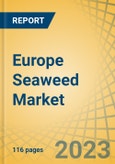According to the research report titled, ‘Europe Seaweed Market by Type (Red Seaweed, Brown Seaweed, Green Seaweed), Form (Dry Form [Powder, Flakes], and Liquid Form), Application (Food and Beverage, Hydrocolloids Extraction, Animal Feed, Agriculture), and Geography - Forecast to 2030,’ in terms of value, the Europe Seaweed Market is projected to reach $5.65 billion by 2030, at a CAGR of 16.6% from 2023 to 2030. Moreover, in terms of volume, the Europe seaweed market is projected to reach 1,815.25 KT by 2030, at a CAGR of 17.7% from 2023 to 2030. The report provides an in-depth analysis of the Europe seaweed market across eleven major countries, emphasizing the current market trends, market size, and recent developments and providing the forecast till 2030.
Succeeding extensive secondary and primary research and an in-depth analysis of the market scenario, the report conducts the impact analysis of the key industry drivers, restraints, opportunities, and challenges. The growth of this market is driven by the rising adoption of plant-based products, increasing consumption of seaweed-based products, and rising government initiatives to boost seaweed cultivation. Seaweed is a rich source of high nutrients and minerals, which further contributes to its increased demand. However, the growing prevalence of natural calamities is expected to restrain the growth of this market to a notable extent. Furthermore, the growing demand for biofuels and technological advancement will provide significant growth opportunities for seaweed manufacturers in the coming years.
Based on type, the red seaweed segment is slated to register the highest CAGR during the forecast period. The rapid growth of this segment is attributed to the growing red seaweed’s application in the food industry, considering its unique taste, nutritional benefits, ease of use, and rising health consciousness among consumers. In addition, the increasing demand for red seaweed to extract hydrocolloids such as agar and carrageenan further supports the growth of this market.
Based on application, in 2023, the food and beverage segment is slated to register the highest CAGR during the forecast period. The rapid growth of this segment is driven by the growing use of seaweed for human consumption, prompted by the rising demand for organic food products and an increase in the consumption of plant-based proteins and vegan products. Moreover, rapid growth in population, increasing awareness of the health benefits of seaweeds, changes in lifestyle and taste preferences among consumers, a shift toward healthy eating habits, and rising disposable income.
An in-depth geographic analysis of the industry provides detailed qualitative and quantitative insights into the eleven major countries/regions (U.K., France, Germany, Italy, Norway, Spain, Ireland, Netherlands, Denmark, Sweden, and the Rest of Europe (RoE)) and the coverage of major countries in each region. France is projected to register the highest CAGR during the forecast period. The high import volume of seaweed, growing demand for clean label products, and growing food supplements market increase the demand for seaweed in the country.
The key players operating in the Europe seaweed market are Seaweed & Co. (U.K.), Cargill, Incorporated (U.S.), Ocean Rainforest (Denmark), Thorverk Hf (Iceland), ALGAplus (Portugal), MYCSA Ag, Inc. (U.S.), Seaweed Solutions AS (Norway), The Seaweed Company (South Holland), Baoji Earay Bio-Tech Co., Ltd (China), Shore Seaweed (U.K.), and Algae (Part of Valagro Group) (Norway).
Key Questions Answered in the Report-
- What is the current value of revenue generated by the Europe seaweed market?
- At what rate is the Europe seaweed demand projected to grow for the next 5-7 years?
- What are the historical market sizes and growth rates of the Europe seaweed market?
- What are the major factors impacting the growth of this market at the regional levels? What are the major opportunities for existing players and new entrants in the market?
- Which segments in terms of type, form, and application create major traction for the manufacturers in this market?
- What are the key geographical trends in this market? Which regions/countries are expected to offer significant growth opportunities for the manufacturers operating in the Europe seaweed market?
- Who are the major players in the Europe seaweed market? What are their specific product offerings in this market?
- What are the recent strategic developments in the Europe seaweed market? What are the impacts of these strategic developments on the market?
Scope of the Report:
Europe Seaweed Market, by Type
- Red Seaweed
- Brown Seaweed
- Green Seaweed
Europe Seaweed Market, by Form
- Dry Form
- Powder
- Flakes
- Other Forms
- Liquid Form
Europe Seaweed Market, by Application
- Food and Beverage
- Hydrocolloids Extraction
- Animal Feed
- Agriculture
- Other Applications
Europe Seaweed Market, by Region/Country
- U.K.
- France
- Germany
- Italy
- Norway
- Spain
- Ireland
- Netherland
- Denmark
- Sweden
- Rest of Europe (RoE)
Table of Contents
Companies Mentioned
- Seaweed & Co. (U.K.)
- Cargill Incorporated (U.S.)
- Ocean Rainforest (Denmark)
- Thorverk Hf (Iceland)
- ALGAplus (Portugal)
- MYCSA Ag Inc. (U.S.)
- Seaweed Solutions AS (Norway)
- The Seaweed Company (South Holland)
- Baoji Earay Bio-Tech Co. Ltd (China)
- Shore Seaweed (U.K.)
- Algae (Part of Valagro Group) (Norway).








